Porcelain Insulator News
by Jack H. Tod
Reprinted from "INSULATORS - Crown Jewels of the Wire", June 1978, page 25
This insulator is owned by Margaret McDermott (Lena, Ill) and we pictured it
in the April 1976 column on page 20. At that time I stated it was probably an
old style of link strain insulator (a fore of dead-ending insulator such as
the O-B pork liver commonly seen).
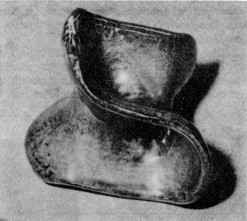
Recently while thumbing my way thru Class 28
(strains) of my card file on insulator patents, I cane upon the card for
patent 1,039,799 shown below. This 1912 gadget for use as a suspension insulator
element sure looks like the same animal as in the above photo. Dora, do we have
a subscriber in France who can dig out a copy of the 1912 Priestley &
Company catalog? Jack
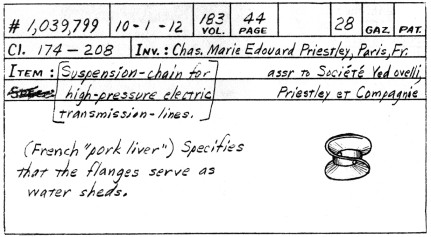
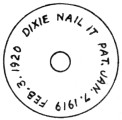
Emma Almeida (Shrewsbury, Mass.) has reported a nail knob with new
markings as shown in the sketch at the right. The following information on it is
all from my new book, "Electrical Porcelain".
The DIXIE could be that of Dixie Electrical Manufacturing Co., Birmingham,
Alabama, a manufacturer of various types of insulators (no other info on the
company).
The NAIL IT (or NAILIT?) was a registered trademark (#147,509 of 10-18-21) of
J. H. Parker & Son, a jobber of electrical equipment in Massachusetts &
West Va. This trademark appears on nail knobs made by more than one porcelain
company.
The 1-7-19 patent is #1,290,540 of G. Glocker, North East, Maryland. The
2-3-20 patent is #1,329,656 of A. H. Fargo, Poughkeepsie, N.Y., and this patent
was licensed widely to various insulator manufacturers.
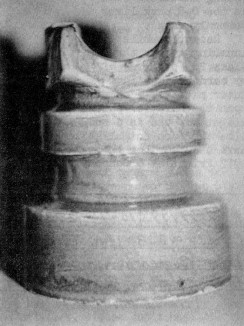
Dear Jack:
We would appreciate any information you could give us on this insulator,
which is comparable to The No. 5 cable in glass and only similar to the U-408 in
the porcelain Universal Style Chart.
It is unmarked and has a very pretty tan glaze color.
One more question, you mentioned in the Sept. 1977 issue of Crown Jewels
that there were four known blue Mickey Mouses (U-395). Jerry Turner has one and
we have 2. We have been wondering who has the fourth one of these?
We are quite pleased that we have come up with this insulator. It is an
"attention getter" in our display at shows, and we are rather proud of
it. So far, we haven't seen any more like it, but would have to assume there are
some somewhere. Bob & Phoebe Adams,
Miami, Florida
- - - - - - - - -
Dear Bob & Phoebe:
Scott & Betty Given (Ohio) have a blue U-395, so I guess that makes it
the fourth one. As far as I know, these all originated with the four that were
originally found by Ron LaSalle (New York) some years ago.

The drawing for the U-408 in the Universal Style Chart was made from the
fussy artist drawing in the 1908 catalog of The New Lexington High Voltage
Porcelain Co., wherein it was labeled the "No. 5 Cable". Most U-408
specimens do approximate closely the U-408 drawing (see photo on page 40 of Feb
1976 CJ), so we never gave it much more thought when the U-408's first
started turning up in late 1974. Presumably these were New Lexington
items.
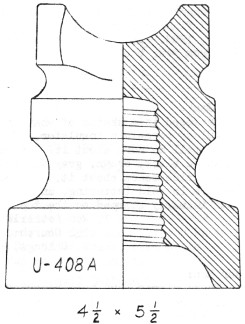
Your specimen is still nominally a "No. 5 Cable" and could be
described as Sim U-408. However, it is distinctly different, and I suspect it
may be a Locke item. Because of the importance of this early and impressive
style, and to possibly assist in identifying the early manufacturers who may
have made these, I think it should be added to the Style Chart as U-408A.
Jack
To: John J. Pines, A. B. Chance Co.
Dear John:
... By the way, it still bugs me about the date written "196?" in
my Porcelain Insulators Guide Book for the year in which A. B. Chance sold the
P.P., Inc. dry press operation at Carey to Clarken Company (and thereafter
operated as Porcelain Products Company). Guess I overworked myself chasing down
the very old dates but was insufficiently inspired to dig out such recent dates.
If you can learn what correct numeral should be substituted for the question
mark in the "196?", please drop me a line some day.
Jack
- - - - - - - - -
Dear Jack:
I checked with the former secretary of the A. B. Chance Co. and find that the
above plant was sold to Clarken Co. July 1, 1963. This should allow you to erase
that question mark from your book.
John
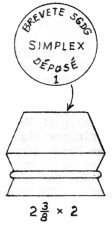
Dear Jack:
Enclosed is a sketch of what might be a threadless porcelain insulator. Could
you please tell me more about it? The color is a mottled black, brown, gray and
red with a slight iridescence about it. The markings here are in gold lettering,
and it also has "1LQ" incusely stamped on the top.
Ron Petrzilka
244 Church
W. Chicago, IL 60185
- - - - - - - - -
Dear Ron.
These gismos have been reported on three previous occasions by Joe Maurath,
Jr. in his insulator column in Old Bottle Magazine (March, May &
October 1975 issues). We still don't know what they are. They could be some form
of insulator, but it shall remain my policy to put such items in the WHATISIT
file unless their use can be attributed with a fair degree of certainty.
The other three were all dug and were from Washington, Florida and New York.
The wording arrangement and numerals varied on all specimens and was variously
applied with black, gold or maroon lettering -- plus some elements incuse stamped.
The Florida collector also has a grossly different item which is marked simply
DEPOSE on its crown.
We've assumed these are of French origin, since the word "FRANCE"
appears in the marking of one of the specimens. My daughter, who speaks fluent
French and lived in France, gave me some guesses about the markings. She says
DEPOSE in this use would mean "patented". Breve means
"short" in French, and -ette (or ete?) is a diminutive in French and
related languages. She says the SIMPLEX is probably a brand or trade-name. This
is positive proof that the sun will continue to rise from an easterly direction
and that approximately 200 of these porcelain gadgets in a burlap bag would make
a very fine boat anchor.
Jack
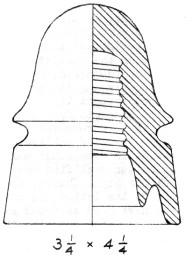
Dear Jack:
I recently acquired a new porcelain insulator in trade and, although it's unmarked,
I think it could be a new "G" item. It is Sin U-248, and I've enclosed
a drawing of it.
I have over 30 of the various "G" insulators, and this one has the
"G" characteristics -- the speckled tan-brown glaze, made by dry
process, the glazed pin hole with a very rounded top, etc.
Unlike the other petticoated "G" insulators though, this one has a
petticoat 1/2" long instead of a very stubby petticoat. Perhaps the company
that made the "G" items made this style different with respect to the
length of petticoat only.
By the way, I would like to buy or trade for a U-272 "G" and a Sim
U-55 "G". I have duplicate U-229 and U-236 "G" to trade,
along with other porcelain or glass. If you know of anyone who has the 272 or
Sim-55 to trade, sure would appreciate it if you could drop me a note on it.
David Bethman
Bellinghan, Wash.
- - - - - - - - - -
Dear David:
Sounds pretty convincing. We should naturally rely on the judgment of those
most familiar with various insulator types, and you probably have seen as many
"G" insulators as anyone around. I do think we can avoid the risk of
having to say "excuse me" later on though if we say only this could be
a "G" item and don't definitely tag it as such until one shows up with
even a faint trace of a "G" marking.
The very rounded top to pin hole is very uncommon in any insulators other
than the "G" ones, but not unknown. The type of glaze isn't 100%
definitive, because "G" came in other glazes also, some of which do
look very much like glazes used by other companies. The longer petticoat is
another minus for the comparison, since the other petticoated "G"
items have uniformly stubby petticoats.
All the "G" styles are made by dry process in a 3-part forming die
(mold). On each, there is a mold line from the rim up to the widest point of the
brow above the top wire groove. Then there is a mold line circularly around this
brow of the wire groove. If your specimen doesn't show traces of mold lines like
that, this would be a definite strike against it being a "G"
item.
Jack
Kerry Lavendoski (Brasher Falls, N.Y.) sent a letter to the National
Insulator Association (NIA) with some detailed thoughts on a possible NIA
project to take an interest in the future assignment and/or rearrangement of CD-
numbers and U- numbers in the insulator Style Charts. He also requested that
John McDougald, NIA president, forward the letter to Crown Jewels for its
possible publication there.
Dora thought it would possibly serve a good purpose if we printed excerpts
from the letter together with comments on it, since she has received in the past
several other letters which likewise involved publication of copyrighted
material by the magazine or some other party not the copyright holder. Since I
am better qualified than Dora to answer questions about the insulator Style
Charts, she asked me if I could prepare a reply to the letter and comment on it
in my column.
I have used selected excerpts from Kerry's long letter (8 pages) which
describe the nature of his presentation, and some portions are slightly edited
for clarity or brevity. My comments following the letter are taken from my reply
letter to Kerry. The detailed explanation about the creation of and updating of
the Style Charts is not only pertinent to Kerry's inquiry but should be of
interest to collectors in any event.
- - - - - - - - - -
Dear John [McDougald]:
... I'm taking you up on your offer to write you about insulator matters as
you invited fellow NIA members and insulator collectors in October 1977 Crown
Jewels.
... I've been collecting about 7 years now .... I still maintain a sizable
collection of CD- numbers, color, Canadians, as well as threadless ones. I even
have quite a few porcelains. I have seen the hobby grow from infancy to what it
is now ..., and I much appreciate the pioneer efforts of Woodward, Milholland,
Tod, Brown and countless others ....
However, I'm just going to focus on one matter that I wonder if the NIA could
take ... a more direct hand in. And that matter is the assigning of CD- numbers
and U- numbers to insulators. These are the standards by which our collectables
are organized, and I'm wondering if the best order has always been used in
assigning these numbers.
I profess to know very little about porcelain insulators .... So I'm not
herein commenting on Jack Tod's decisions on assigning U- numbers to them.
Perhaps porcelain specialists could better comment on that.
[However,] my keen interest in the history and collecting of the earliest
insulators (threadless ones) has always been marred a little bit by the fact
that somehow, and by some one person or persons "along the line",
these insulators have somewhat of a "mixed up" classification. From
CD-700 to CD-744 seems to be rather well organized, but to have the 785, 788 and
790 lumped into the CD-785 to 804 miscellaneous-odd-style category is an
injustice to them ....
From what I've read, the CD- system was devised for threaded insulators
(basically) and when so many threadless began to turn up, a spot just had to be
found for them. Now The CD- system is brilliantly devised for the most part,
starting with the arbitrary number of #100, and the decimal system defining
slight variations is excellently conceived; but considering the apparent
afterthought given to the threadless and foreign types, is it not possible that
a slight change is in order?
My suggestion is this: Since "true" threadless insulators predated
for the most part all threaded insulators ,why not give them a complete category
all to themselves? Perhaps the designation "T" for threadless (North
American) could be used such as:
- T-00 to T-09 = egg styles
- T-10 to T-19 = pin types, narrow skirt
- T-20 to T-24 = Wades
- [etc., 4 other small blocks ending at T-99]
This way much greater space could be opened up to cataloguing threadless
types ... and at the same time retaining a similarity to CD- numbers presently
in use (ie. CD-735 would become T-35 etc.). Possibly the general designations of
narrow skirt and wide skirt could be dropped for two of the categories, and then
that would allow for some types now in one of the other of those categories to
be reassigned. For example, the present CD-742.5 (a rather petite insulator)
could perhaps have a "T" number all to itself along with other small
ones that have turned up.
This method ... would place true threadless insulators numerically before the
threaded insulators [in the CD- Chart] and would ... place them before threaded
types as to actual development too ....
Now I'm wondering what part the NIA could play in such future redefining of
insulators .... I think there is a need for this now ... Also a possible
placing of only North American threadeds in The CD-100 to 375 .... [These
changes] would free the CD-700 to CD-999 category for entirely foreign types. By
changing things now ... we will [have] enough and proper space for yet unfound
North American threadless types as well as the many non-North American types
that will yet be found or made....
Kerry Lavendoski
N.I.A. #1431
- - - - - - - - - -
Comments.
I think Kerry's suggestions are constructive and very well thought out, but I
hope you will see from the following remarks that it just isn't in the cards for
us to ever reassign the reference numbers in the published Style Charts for any
such reasons. As an active worker in the National Insulator Association since
its inception, I am always thankful for any suggestions members have, even if
they may not be implemented for any of various reasons.
I can speak only for the Universal Style Chart (U- numbers) for porcelain
insulators, since that is copyrighted by me. Mr. Woodward would have to speak
for the Consolidated Design Chart (CD- numbers) for glass insulators, since that
is copyrighted by him. Possibly he would agree substantially with the comments I
shall express below.
The Universal Style Chart (U- numbers) is copyrighted by me in my hook
"Porcelain Insulators Guide Book for Collectors". All rights are
reserved, and the Chart or major portions thereof may not be used in any other
publication without my written permission. The U- numbers may be freely used by
any individuals in any manner (articles, listings, ads, etc.) as long as
significant groups of pictures, drawings or cross-reference lists to other
systems are not published in any manner which would preempt the proprietary
value of the published Universal Style Chart itself.
I would never agree to the adulteration of my Universal Style Chart,
including voluntary assignment of U- numbers or change in designation of the
established U- numbers. Likewise, I would not agree to the use of my name (or a
cross-reference of the U- numbers) being used in connection with any other
similar style designation chart. I feel a strong obligation to the hundreds of
collectors who now have and use my Style Chart not to make their books,
checklists, trade lists and collection labeling obsolete by altering any
of the published U- numbers, and I shall exercise my copyright claim in all ways
possible to this end.
There is nothing to stop the NIA or anyone else from creating their own style
chart (it's a free country) as long as my material isn't used in its creation
and as long as my U- numbers aren't cross-referenced to any other chart.
Experience has shown that it automatically creates havoc when the Style Chart
for any collected item (insulators, postal canceling devices, or whatever) is
altered after it has once been published and widely distributed. Indeed, Mr.
Woodward and I corresponded at great length about the possible consequences of
his making even minor changes in his reference numbers for several glass
insulator styles when he adopted the decimal system to facilitate the addition
of more numbers to his CD- Chart in crowded portions with no vacant numbers.
There are hundreds of collectors who have the first edition of Porcelain
Insulators Guide Book who have not, or never will, obtain the current second
edition or any later possible editions of the book. You can imagine the horrors
of newer collectors operating with Charts having numbers differing from the
numbers in the Charts still being used by hundreds of other established
collectors. Nothing like buying or trading for a Mickey Mouse (U-395) only to
have it arrive and turn out to be some sort of Pony insulator (since the seller
used a later alteration of the Style Chart)!
It is thus prudent for anyone creating Style charts to think about how such
SNAFU's can occur and then set down some ground rules to avoid then.
First, and most important, the reference numbers should never he
changed once they have been published. Once you publish a Chart showing the
Mickey Mouse as U-395, you can't ever later change it to U-396, U-425, or
anything else.
Secondly, if you later remove some style from the Chart and vacate its
number, you shouldn't reuse the vacated number for some later addition. The
SNAFU's that would result from reusing old numbers should be obvious.
A considerable amount of thought must he given to reference number
assignments when the Style Charts are being readied for first publication, since
you know you're stuck with the numbers for given styles from there on out. The
first porcelain U- Chart had only about 650 designations. Even at that, I
guessed that half again that many additional styles would surface later with
additional research at the factories and with collectors reporting styles not
shown in the first publication of the Chart.
I labored for weeks trying to arrange those 650 insulators in some logical
order and completely wore out a perfectly good crystal ball trying to guess just
where to leave the vacant numbers in the 1-999 block for inclusion of later
styles unknown at that time. This was desirable even though the numbering system
even initially was expanded by the use of suffixes (ie. U-98, U-98A, U-98B,
etc.). It was a real struggle to determine where to place some items in the
Chart; for instance, how about the U-100 which is both a duplex insulator
and a transposition insulator! Some insulators were such odd styles they just
wouldn't fit anywhere, and most of those were just lumped into the U-395 to
U-435 area (and which subsequently got very crowded for any unused numbers as
new oddities continued to show up).
The number of new styles added after the original publication came out just
about as I had predicted; there are 943 in the Second Edition of the book, and
new additions are now down to a tiny trickle. Most of the new items did fit very
well into the vacant numbers, but a couple of areas in the Chart became slightly
crowded for numbers. My crystal ball had worked pretty well after all.
Even though both the glass insulator CD- Chart and the porcelain insulator U-
Chart turned out admirably well in the end, the above discussion should make it
clear that we will just have to live with any slight misarrangements caused by
Woody and I not being able to work our crystal balls to perfection. Both Charts
are too well established and universally used to ever consider altering them in
terms of number revisions or replacement with some new form of Charts
altogether.
The sole purpose of the Charts is to provide reference numbers definitive to
any insulator shape, and they are useful in magazine articles, trade lists,
letters, ads, check lists, labeling collections, etc. As such, the reference
numbers can be completely arbitrary, and the basis for Chart arrangement is
purely to make it easy to find insulators in the Chart. This seems to work best
if arrangement is based on size and shape (with some interior grouping such as
telephone, power, grooved crowns, double petticoats, etc.).
To some degree, this arrangement is incompatible with other arrangements
concerning antiquity (as you discuss), manufacturer, pin hole sizes, etc. What
the reference number is really makes no difference except for ease of finding
the insulator in the Chart. Even if I saw a threadless listed as a CD-584379, I
could always thumb back to that number in the Chart and instantly see what the
fellow was talking about. That's what counts. It doesn't change the insulator's
vintage, value, desirability or importance one iota if it happened to be
designated CD-1.
In both the CD- Chart and the U- Chart, reference numbers for threadless
styles are in high-number blocks solely because the low numbers were already in
use by other insulators in the first published Charts. In the case of
porcelains, only several threadless were even known when the U- Chart was first
created, and I hadn't been able to obtain drawings of even those by 1971. No
telling what others might turn up in the future either, so I just reserved the
numbers from U-970 to U-999 for anything threadless that ever did show up. It's
simple, if you ever have the good fortune to get a porcelain threadless, just
look on the last page of the U- Chart, and you'll instantly be able to see what
its U- number is.
Admittedly, if all these threadless porcelains we now have had been known in
1971, I possibly would have put them at the start of the U- Chart. At the time,
it would have seemed wasteful to use a block of nice low numbers for something
which we didn't even know to exist for sure. Besides, the low numbers are
handier for styles listed and traded every day. Just how often do we have to
refer to the U-986, considering there's only one specimen known, and it's
resting comfortably in someone's collection?
There you go -- a very long answer which possible befits the very long
question.
Jack H. Tod N.I.A. #13
| 